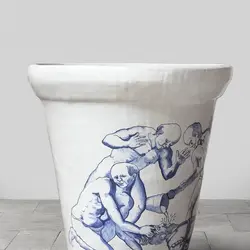Ai Weiwei
b. 1957, China
Rebar 21, 2008
Reinforcement steel in three parts
51 x 206 x 45 cm
Rebar 21 consists of three steel rebars, typically used in conjunction with concrete to enhance the structural integrity of construction projects. Aesthetically arranged here, they carry a deeper and more sombre significance, serving as a stark reminder of the tragic consequences of poor building practices exposed by the 2008 Sichuan Earthquake in China.
The devastating earthquake resulted in the catastrophic collapse of several schools in the rural province of Sichuan, leading to the loss of countless lives, especially among children. Ai Weiwei was deeply affected by this disaster and actively participated in identifying the deceased children, even galvanising a citizens' initiative to do so against significant resistance from the authorities.
In Rebar 21, Ai Weiwei encapsulates the essence of his broader message: to bear witness to history's darkest moments, challenge official narratives, and honour the memory of those who perished in the Sichuan Earthquake.
Ai Weiwei (b. 1957, China)
Ai Weiwei is a contemporary artist, documentarian, and activist, known for being one of China's most vocal political commentators. His father was imprisoned in a labour camp as a revolutionary enemy, while his family lived in exile under harsh conditions until 1976. After attending the Beijing Film Academy from 1978 to 1981, Ai moved to the United States, temporarily attending Parsons School of Design. He returned to China in 1993, and was arrested in 2011 for "economic offences". Ai has openly criticised the Chinese government's attitude on democracy and human rights, looking into government corruption and cover-ups. Ai utilises art to challenge China's socio-political structure, manipulating Chinese cultural artefacts to juxtapose the materiality and tradition of the country's imperial history.
Ai has received various accolades, including the Chinese Contemporary Art Award (2008), Honorary Academician at the Royal Academy of Arts, London (2011), and the Václav Havel Prize for Creative Dissent (2012). Among his solo exhibitions are those at the Mori Art Museum, Tokyo (2009), Tate Modern, London (2010), and Hirshhorn Museum and Sculpture Garden, Washington D.C. (2012).
















